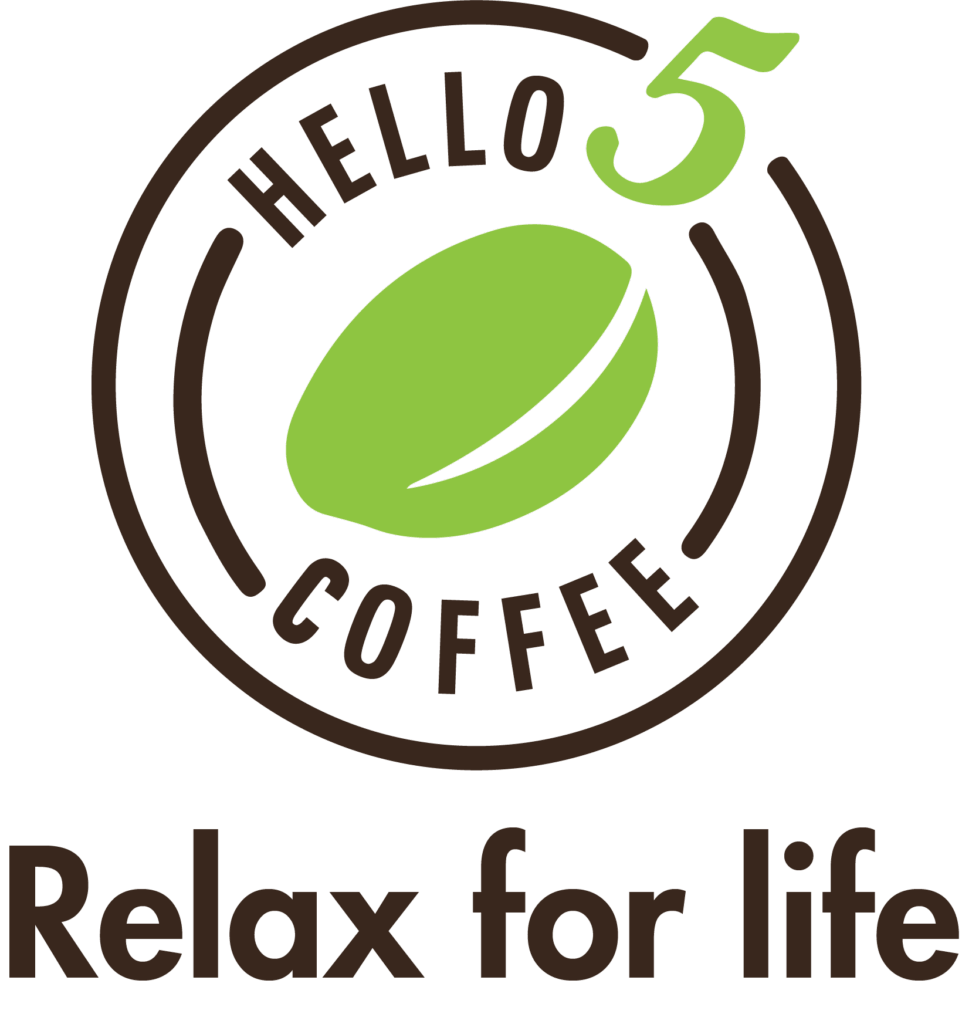Are you looking to import high-quality coffee from Vietnam but don’t know where to start? Vietnam is the world’s second-largest coffee exporter, offering a wide range of Robusta, Arabica, and specialty coffees that meet international standards. This guide will walk you step by step through the entire import process, so you can confidently source Vietnamese coffee for your business.
Overview of importing coffee from Vietnam
Export statistics
Vietnam is the world’s second-largest coffee exporter, after Brazil, with Robusta coffee being the main production. According to data from the Ministry of Agriculture and Rural Development (MARD), in the 2023-2024 crop year, Vietnam exported approximately 1.32 million tons of coffee, achieving a record value of 5.48 billion USD, an increase of 29.1% compared to the previous year.
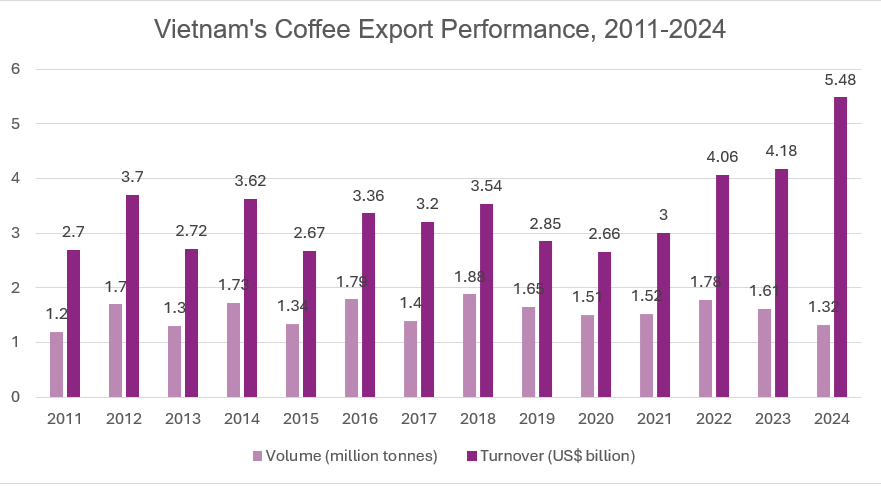
Notably, the average export price in 2024 reached 4,177 USD/ton, an increase of 59% compared to 2023. This demonstrates that Vietnamese coffee quality is increasingly recognized worldwide.
Main Export Markets
Vietnamese coffee is exported to over 80 countries, with major markets including:
- Germany: 705 million USD
- United States: 610 million USD
- Italy: 475 million USD
- Japan: 355 million USD
- Spain: 320 million USD
- Belgium: 290 million USD
- Russia: 265 million USD
- South Korea: 230 million USD
- Philippines: 205 million USD
- United Kingdom: 190 million USD
- …
Types of Vietnamese Coffee Exports
Robusta Coffee
- Export market share: Accounts for approximately 95% of Vietnam’s total coffee export volume.
- Characteristics: Robusta coffee beans have a strong flavor and high caffeine content, commonly used in instant coffee and espresso production.
- Production volume: In 2023-2024, Vietnam exported approximately 1.25 million tons of Robusta coffee, achieving a value of about 4.5 billion USD.
Arabica Coffee
- Export market share: Accounts for approximately 5% of Vietnam’s total coffee export volume.
- Characteristics: Arabica coffee beans have a mild flavor with bright acidity, favored in specialty coffee varieties.
- Production volume: In 2023-2024, Vietnam exported approximately 65,000 tons of Arabica coffee, achieving a value of about 300 million USD.
Instant Coffee
- Export market share: Accounts for approximately 15% of Vietnam’s total coffee export volume.
- Characteristics: Instant coffee is produced from high-quality Robusta coffee, meeting the demand for quick and convenient consumption.
- Production volume: In 2023-2024, Vietnam exported approximately 180,000 tons of instant coffee, achieving a value of about 1.2 billion USD.
Roasted & Ground Coffee
- Export market share: Accounts for approximately 5% of Vietnam’s total coffee export volume.
- Characteristics: Processed coffee that is pre-roasted and ground, suitable for consumer markets with high quality and flavor requirements.
- Production volume: In 2023-2024, Vietnam exported approximately 65,000 tons of roasted and ground coffee, achieving a value of about 450 million USD.
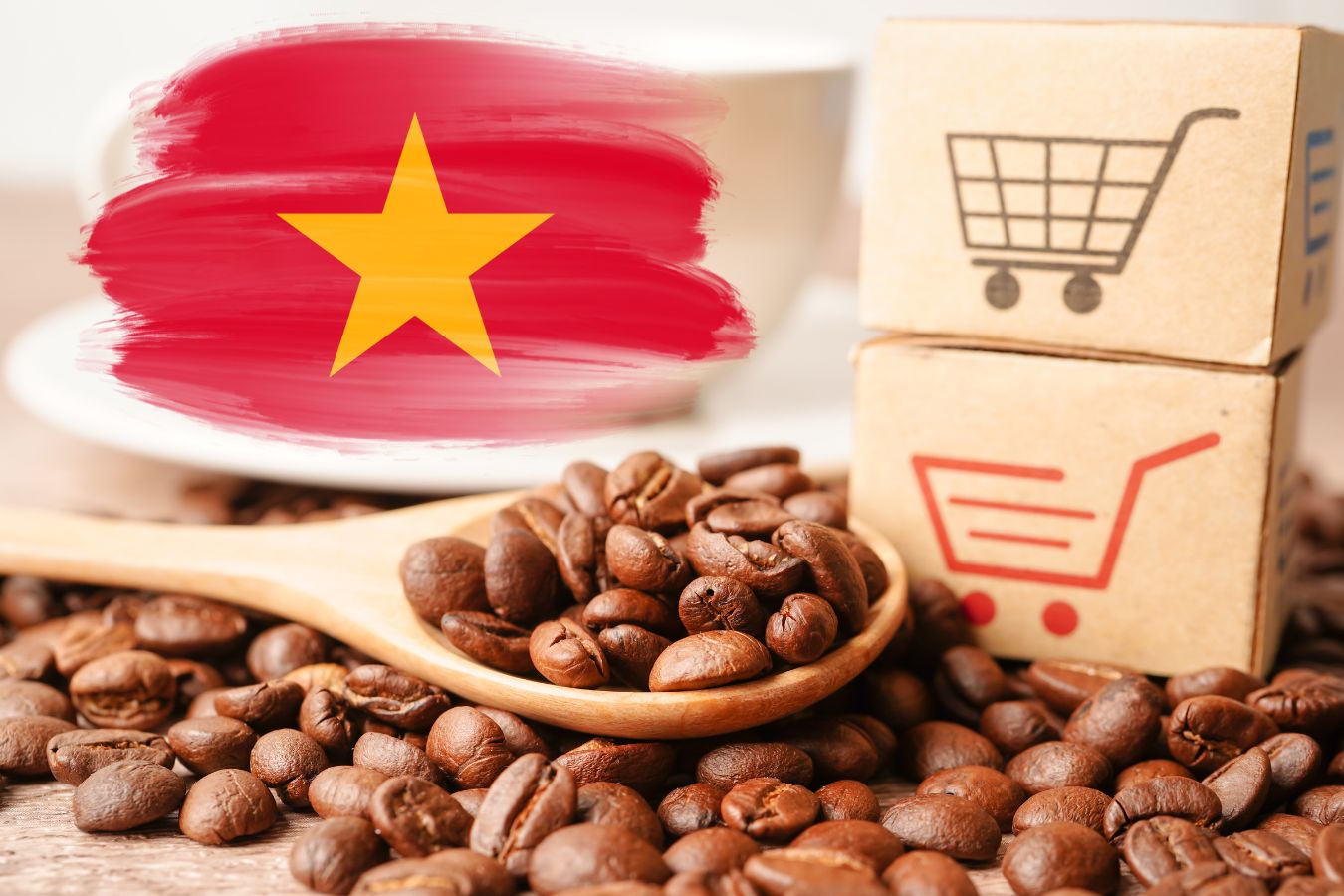
Largest Vietnamese Coffee Suppliers
In 2023-2024, some of the largest coffee suppliers in Vietnam recorded:
- Intimex Group: 468 million USD.
- Vinh Hiep Co., Ltd: 408 million USD.
- Louis Dreyfus Vietnam: 324 million USD.
- Nestlé Vietnam: 305 million USD.
- Tuấn Lộc Commodities: 269 million USD.
- Daklak 2-9 Import Export: 259 million USD.
- Sucafina Vietnam: 252 million USD.
- …
Read now:
Step-by-step Guide to Importing Coffee from Vietnam
When deciding to import coffee from Vietnam, many international businesses, especially American and European customers, often wonder where to start the specific process, what to prepare, and how to avoid risks. Below is a detailed step-by-step guide:
Step 1: Selecting Reputable Coffee Suppliers in Vietnam
If you are new and have never imported coffee from Vietnam before, the safest way to find reputable suppliers is to start with official channels such as VICOFA or VietnamTradePortal to get a list of reputable enterprises. Then, you should request small samples before placing large orders and prioritize working with companies that have international certifications (Fairtrade, Organic, Rainforest Alliance). If possible, participate in trade fairs and exhibitions like Vietnam Coffee Expo to directly meet and negotiate with suppliers.
To choose a reputable coffee supplier in Vietnam, you should follow these evaluation criteria:
- Verify legal status: Check business licenses, tax codes, and export registrations of the enterprise. You can search on the information portal of the Ministry of Industry and Trade or the Vietnam Coffee and Cocoa Association (VICOFA).
- Assess production capacity: Prioritize units that own their own raw material areas or have partnerships with farmers under sustainable models. They should have modern processing facilities that meet international standards (ISO, HACCP).
- Check quality certifications: If you are importing to the US, look for international certificates such as Organic, Fairtrade, UTZ, Rainforest Alliance. These are “passports” that help Vietnamese coffee easily enter the US market.
- Review export history: A supplier who has previously exported to the US, EU, or Japan is usually more reliable, as they are familiar with strict quality and safety standards.
- Evaluate service and communication: Try working with them: request quotes, ask for samples, see if they respond quickly and professionally. A reputable supplier will be transparent about pricing, contract terms, and ready to support logistics (FOB, CIF).
Selecting suppliers is the first and most important step in the import process, so you need to invest a lot of time in this step. Some reputable coffee exporters in Vietnam include:
- Trung Nguyen Coffee Corporation: Known for high-quality instant coffee products, Trung Nguyen has factories in Binh Duong and Bac Giang, with a capacity of about 50,000 tons of instant coffee per year.
- VinaCafe: Specializing in providing instant coffee and roasted ground coffee products, VinaCafe has an extensive distribution network and long-standing reputation.
- Vietnam Good Coffee Ltd.: Part of CCL Products Group (India), specializing in providing instant coffee with capacity up to 10,000 tons/year.
- Intimex Group: One of the leading coffee export groups in Vietnam, Intimex Group exported more than 404,000 tons of coffee in 2022.
- Simexco Daklak: Famous for high-quality robusta coffee, especially from the Dak Lak region.
- Hello 5 Coffee is also a reliable manufacturer, supplier & exporter. We specialize in providing high-quality processed Vietnamese coffee with traceable origins from Buon Me Thuot farms, Dak Lak & Cau Dat, Lam Dong.
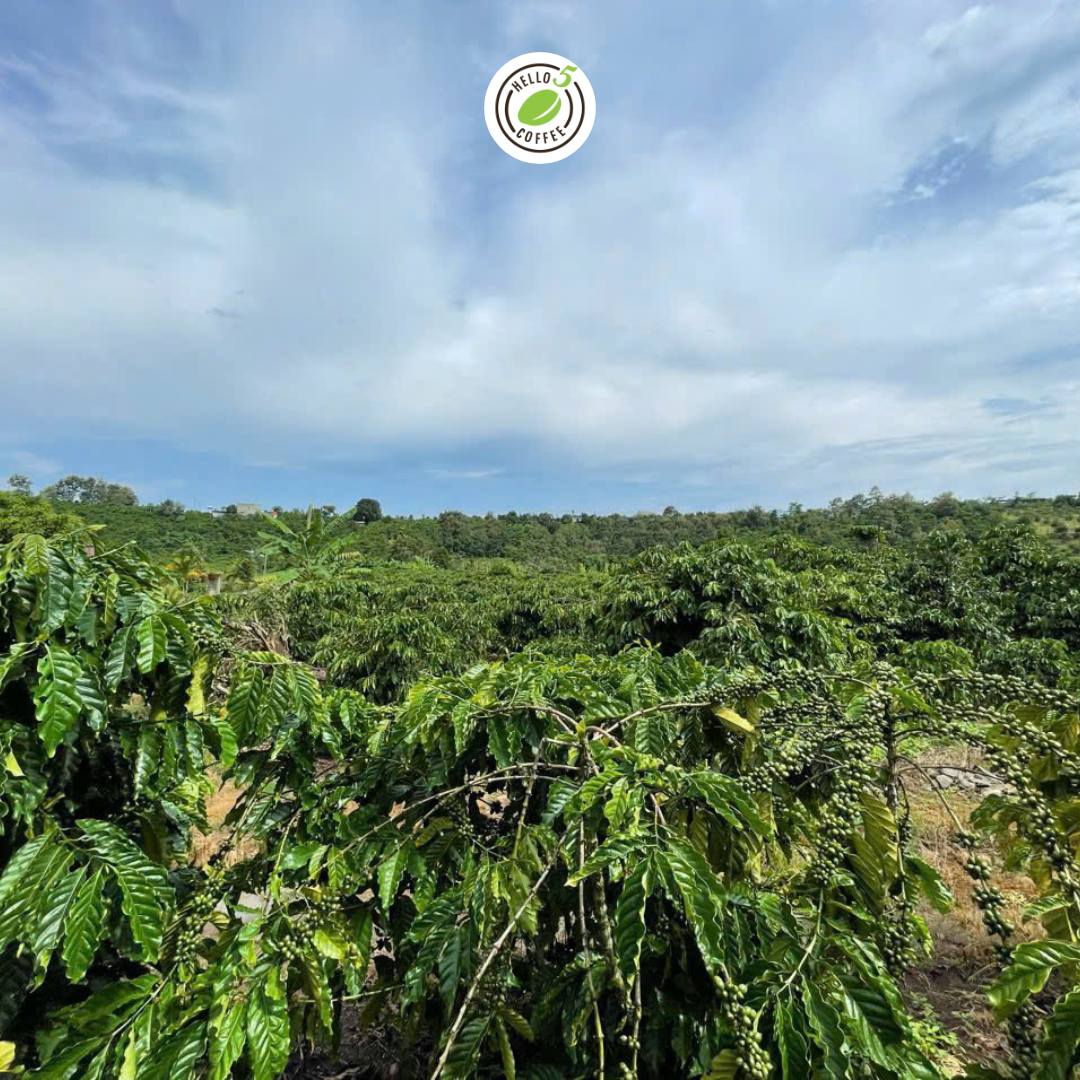
Step 2: Negotiating and Signing Contracts
After selecting a suitable coffee supplier, the next extremely important step is negotiating and signing contracts. This is the stage that determines whether you can buy quality coffee at competitive prices and limit risks in international transactions.
Preparation before negotiation
- Know market prices: You should refer to Vietnamese coffee prices from sources such as the Vietnam Coffee and Cocoa Association (VICOFA), trading floors (ICE, London, NYSE), or international trade reports. For example, the export price of Vietnamese robusta green coffee in 2023 ranged around 2,400 – 2,600 USD/ton, depending on type and quality.
- Clearly define needs: Type of coffee (robusta, arabica, organic…), volume, roasting/grinding specifications, packaging, delivery time, destination port (USA usually imports through Port of Houston, Port of New Orleans, or Los Angeles).
- Prepare a requirements list: quality standards, certifications (Organic, Fairtrade, Rainforest Alliance…), logistics services, payment terms.
Smart bargaining strategy
- Get multiple quotes: Contact at least 3–5 suppliers to get a price baseline before negotiating.
- Order samples first, order small first: Start with a trial order (5–10 tons) to verify quality, then use it as a “weapon” in negotiating large lots.
- Use favorable Incoterms: If you are new to importing, choose CIF (Cost, Insurance, Freight) so the supplier handles shipping and insurance to US ports. Once familiar, you can switch to FOB for self-managed logistics, which is usually more economical.
- Request quantity discounts: Most Vietnamese coffee suppliers will reduce prices when you import from 20 tons (1 container) or more. Don’t hesitate to request an additional 2–5% discount for quick payment.
Important clauses in contracts
A standard coffee import contract should include:
- Detailed product information: type of coffee, broken bean ratio, maximum moisture content, bean size, roasting/grinding standards, packaging (jute bags, paper bags, 60kg or 70kg).
- Trade terms (Incoterms 2020): CIF, FOB, EXW… clearly stating cost responsibilities of each party.
- Payment terms: Most common for US-Vietnam transactions are L/C (Letter of Credit) or T/T (Telegraphic Transfer). If you’re new, L/C is safer but more expensive.
- Delivery schedule: divided into multiple shipments or delivered at once. Clearly state expected time, export port (usually Cat Lai – HCMC or Hai Phong) and import port (US).
- Inspection clauses: require third-party inspection by SGS, Intertek to ensure coffee meets committed quality before shipment.
- Insurance & dispute resolution clauses: clearly state who is responsible in case of damage or loss of goods; resolve disputes at Vietnam International Arbitration Centre (VIAC) or Singapore.
According to Hello 5 Coffee’s 12 years of industry experience, here are some tips that can help you gain more advantages when importing Vietnamese coffee:
- First, don’t just focus on price, consider stable quality and after-sales service. A reputable coffee supplier is usually willing to support you long-term.
- Next, show long-term cooperation commitment with suppliers, clearly stating that if the first order goes smoothly, you will expand the volume. This often helps you get additional discounts.
- Finally, always carefully check every detail in the contract before signing. If you’re not familiar, hire an international commercial lawyer or customs broker in the US to review.

Step 3: Preparing Documents and Export-Import Procedures
After negotiating and signing contracts, the next step to import coffee from Vietnam into the domestic market is to prepare complete documents and export-import procedures (depending on each country will have different requirements, below we take the example of importing Vietnamese coffee into the US market). This is a very important part, because just missing or getting one small detail wrong, the shipment can be delayed in customs clearance, even returned.
Export document set from Vietnam side
A legitimate Vietnamese coffee export shipment usually needs:
- Commercial Invoice: Shows seller information, buyer, shipment value, Incoterms conditions.
- Packing List: Lists number of bags, net weight, gross weight, packaging type, dimensions.
- Bill of Lading (B/L): Issued by shipping company, certifying goods have been loaded on ship.
- Certificate of Origin (C/O Form B): Issued by Vietnam Chamber of Commerce and Industry, confirming goods originate from Vietnam.
- Phytosanitary Certificate: Issued by Vietnam Plant Protection Department, confirming coffee carries no harmful pests or diseases.
- Quality Certificate: Usually issued by international inspection units like SGS or Intertek, ensuring coffee meets agreed standards.
Requirements for importing coffee into the US
In the US, coffee belongs to agricultural food products, therefore needs to meet:
- FDA Prior Notice: Before goods arrive at port, you must notify the US Food and Drug Administration (FDA) for approval. Without this step, goods may be detained.
- US Customs Entry Filing: Goods entering the US must be declared with US Customs and Border Protection (CBP). Usually you will work with Customs Broker to file import declaration.
- Food safety certification: If importing roasted ground coffee or instant coffee, sometimes you need to provide additional documents related to production facilities meeting HACCP, ISO or equivalent standards.
Actual process when importing coffee into the US
- After coffee is loaded on ship at Vietnamese port (Ho Chi Minh or Hai Phong), the supplier sends you the original document set via DHL or FedEx.
- You transfer this document set to Customs Broker in the US for them to declare imports with CBP.
- Simultaneously, notify Prior Notice to FDA before goods arrive at port at least 2 hours for sea freight.
- When the ship arrives at US port (e.g., Houston, New Orleans, Los Angeles), goods will be inspected by CBP for documents. If documents are complete, goods are cleared, then you can take goods to warehouse or hire domestic logistics for transportation.
Important notes to avoid risks
- Ensure information on Invoice, Packing List and Bill of Lading match absolutely (product name, container number, weight, loading/unloading ports).
- Always request soft copies of documents to check before supplier sends originals.
- For new customers, choose CIF so supplier handles transportation and insurance, helping you focus on US import procedures.
- Always work with a reputable Customs Broker in the US, they will guide you accurately through each step and handle CBP, FDA on your behalf.
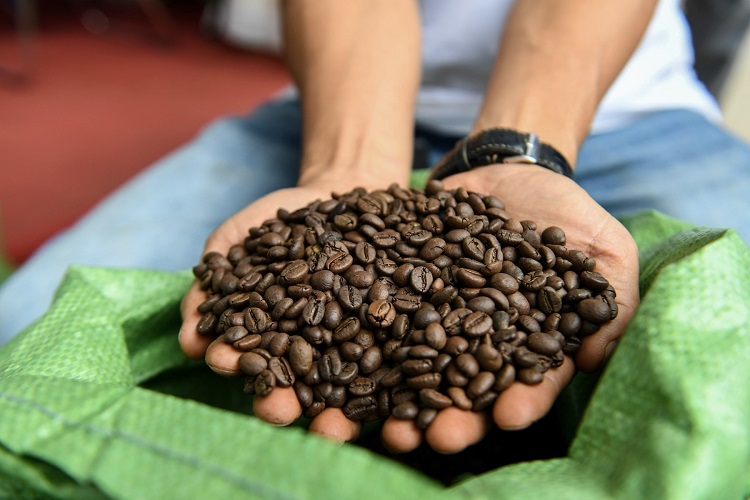
Step 4: Transportation and Customs Clearance
After preparing complete documents, the next step is organizing transportation and customs clearance procedures. This is the stage that determines whether coffee reaches you in the US on time, with correct quality, and at optimal cost.
International transportation from Vietnam to US
Common transportation methods:
- Sea Freight: Top choice for coffee imports due to low cost, suitable for large volumes (each container usually carries 18–20 tons of green coffee). Transportation time from Cat Lai port (Ho Chi Minh) or Hai Phong to US usually 25–35 days, depending on destination port.
- Air Freight: Fast (3–7 days), but cost is many times higher, should only be used for samples or special small lots.
- Main export ports in Vietnam: Cat Lai (Ho Chi Minh), Hai Phong, Da Nang.
- Main import ports in US: Houston (Texas), New Orleans (Louisiana), Los Angeles/Long Beach (California).
Estimated transportation costs:
- Sea freight 1 x 20ft container from Vietnam to US: about 2,500 – 4,000 USD (depending on season, shipping line, destination port).
- Air freight: about 5–7 USD/kg, usually not economical for large coffee quantities.
Logistics management and insurance
- If you’re new to importing, choose CIF (Cost, Insurance, Freight), meaning supplier handles transportation and insurance to US port.
- When familiar, you can choose FOB (Free on Board), to control shipping line and usually save costs.
- Always ensure cargo insurance to prevent risks of damage, mold or loss during sea transport.
Customs clearance procedures in the US
- Cargo entry: When ship arrives at US port, shipping line will send Arrival Notice. You or Customs Broker will submit document set to US Customs and Border Protection (CBP).
- FDA Prior Notice: If not declared, goods may be detained. This is mandatory requirement for food products.
- Customs inspection: CBP may allow quick clearance if documents are complete, or physically inspect container if suspicious.
Pay taxes and fees:
- For raw unroasted coffee beans, import duty to US is currently 0%, giving Vietnamese coffee competitive advantage.
- If roasted ground coffee or processed coffee, you may have to pay additional consumption tax and food safety inspection.
- Clearance and goods receipt: After completion, goods will be released and you can take to warehouse or hire domestic transportation services.
Important notes during transportation and customs clearance: If shipment is randomly inspected, you should fully cooperate with CBP, while maintaining close contact with coffee supplier in Vietnam.
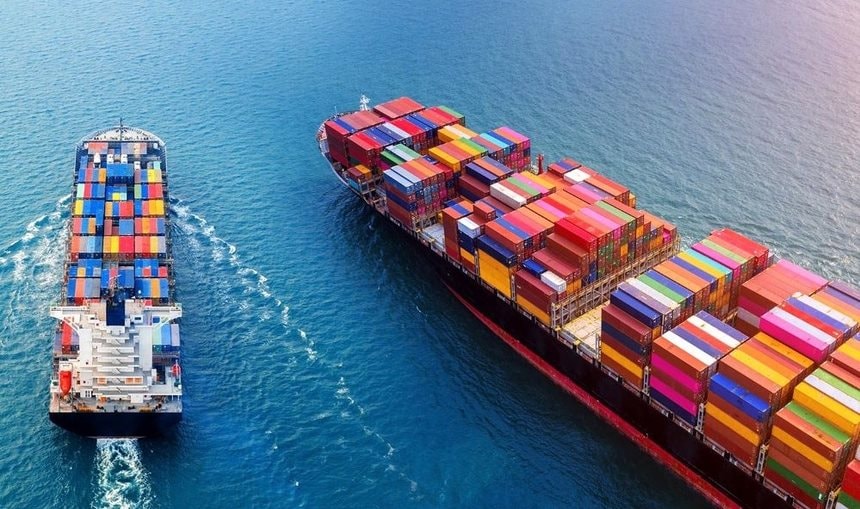
Step 5: Receiving Goods and Payment
This is the final step in the coffee import process from Vietnam, but extremely important as it directly relates to your money and legal rights. If managed well, you both protect capital and maintain sustainable relationships with Vietnamese suppliers.
Receiving goods at port or warehouse
Check goods condition:
- When container arrives at port or your warehouse, unseal immediately and check: number of bags, actual weight, packaging condition, moisture, aroma.
- For green coffee beans, measure moisture (11–12%) and check for broken beans, black beans, insect-damaged beans.
- For roasted ground coffee, ensure no signs of mold, strange odors, or torn packaging.
Record minutes:
- If problems are found, make on-site survey report with photos, videos, witnessed by third party (forwarder or surveyor). This will be important evidence if you need to file complaints.
Payment according to contract terms
Depending on initial agreement, common payment methods include:
T/T (Telegraphic Transfer – international wire transfer):
- Most common, usually divided into 2 times: 30% deposit when signing contract, 70% after receiving B/L scan copy.
- Should apply for small orders when trust has been established.
L/C (Letter of Credit):
- Safe for both parties, as bank guarantees payment.
- Usually used for large orders (from 1 container up), as L/C opening fee is about 0.5–2% of contract value.
CAD (Cash Against Documents):
- Buyer pays immediately upon receiving original document set from bank.
- Suitable when having long-term business relationships.
Tips to optimize payment
- If you’re importing for the first time, start with small trial orders (1–2 tons, or few pallets) before signing large contracts.
- Always retain 10–15% of order value to pay after goods arrive and are inspected (except when using L/C), to increase safety level.
- Use reputable international banks (HSBC, Citibank, JP Morgan…) or banks with branches in Vietnam to avoid transaction delays.
- If working with large suppliers (Intimex, Simexco, Vinacafe, Hello 5 Coffee,..), you should use sight L/C to create professionalism.
Resolving disputes if any
In case goods quality doesn’t match commitments:
- First, notify supplier in writing within 5–7 days.
- Use survey certificates from international organizations (SGS, Intertek, Bureau Veritas) as evidence.
- If both parties cannot reach agreement, disputes can be resolved through international commercial arbitration (ICC, VIAC) if clearly stated in contract.
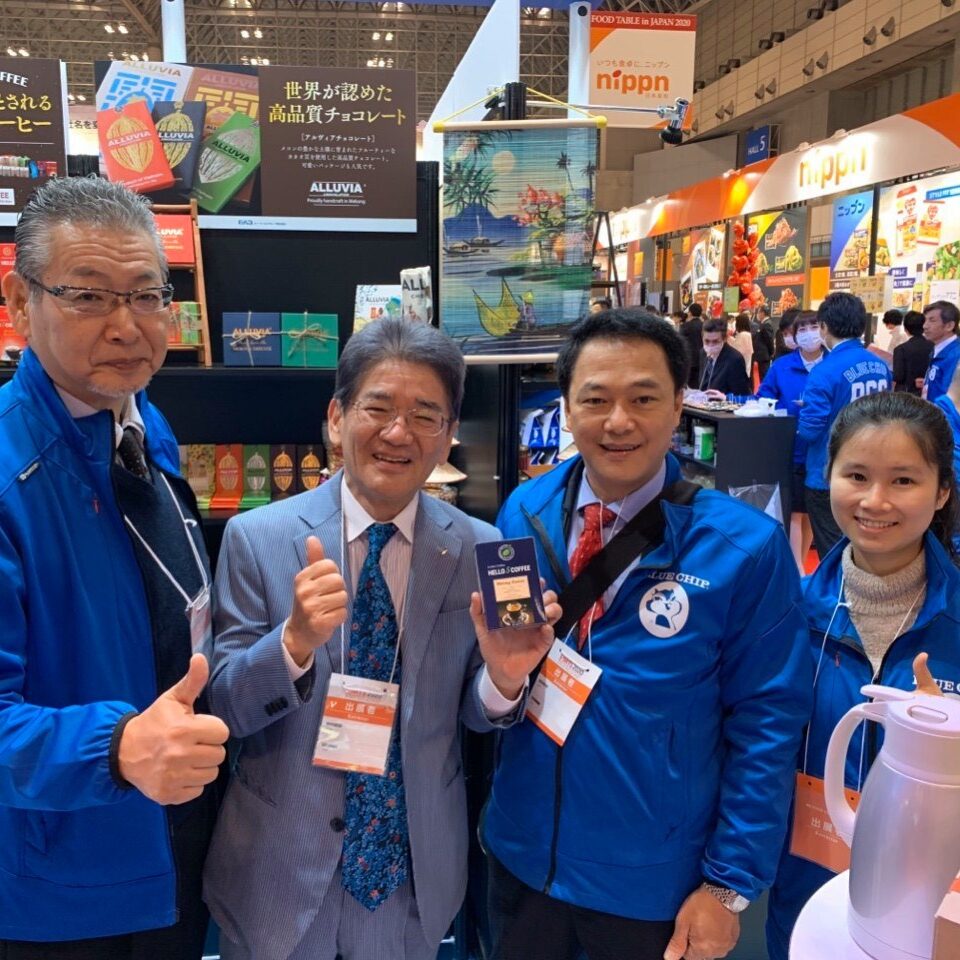
Why You Should Import Vietnamese Coffee Today
When mentioning coffee, many people think immediately of Brazil or Colombia, but Vietnam is truly the “silent star” on the world coffee map. Not only is Vietnam the world’s number 1 Robusta coffee exporter, Vietnam is also increasingly asserting its position in specialty Arabica coffee with stable quality and competitive prices. This is why importers in the US, Europe and many major markets are increasing their proportion of coffee purchases from Vietnam.
Stable production and consistent quality
Coffee growing regions in Vietnam such as the Central Highlands (Dak Lak, Gia Lai, Lam Dong) are located at altitudes from 400–1,500m, with temperate subtropical climate (15–26°C) and abundant rainfall and sunlight. Thanks to these ideal natural conditions, Vietnam maintains stable production of over 1.6–1.8 million tons of coffee/year, accounting for about 15% of total global coffee exports (2023).
The special point is that each region focuses only on one main type of coffee: Robusta in Dak Lak, Arabica in Lam Dong (Da Lat), creating high specialization in cultivation and processing. This helps Vietnamese coffee quality remain consistent through each harvest season, an advantage that not every country can achieve.
More competitive prices than international market
One of the biggest reasons to import Vietnamese coffee is FOB prices about 5–7% lower than global average. For example, in 2023, Vietnamese Robusta coffee FOB prices ranged 2,300–2,600 USD/ton, while the same type from Indonesia or India was usually higher.
Therefore, many developed countries like Germany, Italy, US, Russia choose Vietnam as their main supply source. Even according to the International Coffee Organization (ICO), Germany – the largest coffee consuming country in the EU – imports up to 25% of Robusta from Vietnam to serve the roasting and instant industry.
Advantages in tariffs and trade agreements
Vietnam is participating in many free trade agreements (FTA) giving Vietnamese coffee special advantages:
- EVFTA (EU-Vietnam Free Trade Agreement): import duties on green, roasted or processed coffee beans into EU reduced from 7–12% to 0%. Additionally, EU commits to protect 39 geographical indications of Vietnam, including Buon Ma Thuot coffee, creating competitive advantage for specialty products.
- CPTPP (Comprehensive and Progressive Trans-Pacific Partnership Agreement): opens doors for Vietnamese coffee to Japan, Canada, Australia… with tariff preferences.
- UKVFTA (UK-Vietnam FTA): after Brexit, Vietnam continues to receive tariff exemptions and reductions for coffee exports to UK, one of Europe’s most developed coffee markets.
Global consumption trends support Vietnamese coffee
While Arabica dominates in US and Europe, Robusta is increasingly favored thanks to high caffeine content, strong bitter taste, and especially its role as main ingredient for instant coffee – a segment growing rapidly globally.
Major brands like Nestlé, JDE Peet’s, Starbucks all use Vietnamese Robusta in their supply chains. Nestlé alone has invested over 700 million USD in Vietnam over many years to ensure stable supply for instant coffee production.
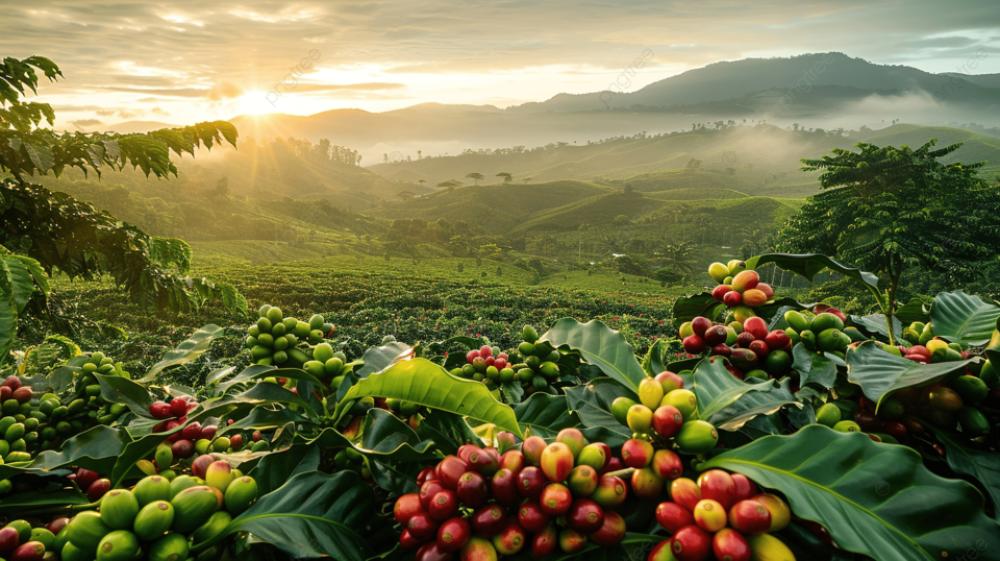
Above is all the information guiding Vietnamese coffee import compiled from Hello 5 Coffee’s 12 years of industry experience. We hope this article has provided you with useful information. We are always here, if you have difficulties importing Vietnamese coffee in large quantities, contact immediately Email info@hello5coffee.com or WhatsApp (+84) 81 535 5505.
